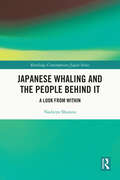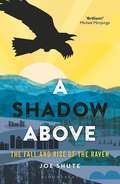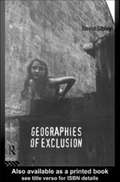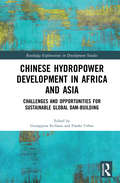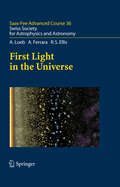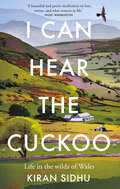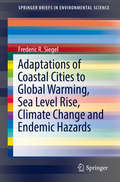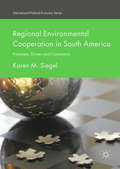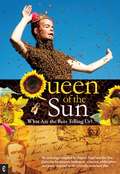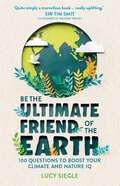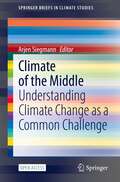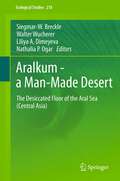- Table View
- List View
Environmental Concerns and Sustainable Development: Volume 1: Air, Water and Energy Resources
by Vertika Shukla Narendra KumarThe prevailing global environmental crisis is primarily because of non-standardized parameters for environmental regulation. Unplanned expansion of economic activities, consideration for environmental conservation and several associated problems are emerging due to degradation in quality of ambient environment such as clean air, safe drinking water and quality of food, particularly in developing nations. Due to poor/casual execution of EIA protocol, newly developing countries are preferred destination for establishing pollution emitting industries, which results in degradation and depletion of natural resources. Lack of environmental policy intervention is another major attraction for establishing such industries in these nations. In order to ensure sustainable development, the highest priority issues include the monitoring and eradication of environmental problems which arise due to economic development. Initiation of any form of economic development primarily results in loss of forests and thus biodiversity, followed by deterioration in quality of air and contamination of natural resources. The worst impact of non-standardized economic development is the contamination of air, water and soil. Sustainable development ensures responsible interface with the environment to minimize the depletion or degradation of natural resources and ensure long term environmental quality. It involves integrated approaches in understanding the importance of environmental management systems and policy inventions leading to improved environmental performance. The present book is proposed to address the environmental concerns associated with economic development and approaches involved to attain sustainable economic development, which include monitoring of the quality of air, deforestation, quality of water resources, soil erosion and degradation of the natural environment.
Urban Ecology: An International Perspective on the Interaction Between Humans and Nature
by Eric Shulenberger Wilfried Endlicher Marina Alberti Gordon Bradley Clare Ryan Craig ZumBrunnen Ute SimonUrban Ecology is a rapidly growing field of academic and practical significance. Urban ecologists have published several conference proceedings and regularly contribute to the ecological, architectural, planning, and geography literature. However, important papers in the field that set the foundation for the discipline and illustrate modern approaches from a variety of perspectives and regions of the world have not been collected in a single, accessible book. Foundations of Urban Ecology does this by reprinting important European and American publications, filling gaps in the published literature with a few, targeted original works, and translating key works originally published in German. This edited volume will provide students and professionals with a rich background in all facets of urban ecology. The editors emphasize the drivers, patterns, processes and effects of human settlement. The papers they synthesize provide readers with a broad understanding of the local and global aspects of settlement through traditional natural and social science lenses. This interdisciplinary vision gives the reader a comprehensive view of the urban ecosystem by introducing drivers, patterns, processes and effects of human settlements and the relationships between humans and other animals, plants, ecosystem processes, and abiotic conditions. The reader learns how human institutions, health, and preferences influence, and are influenced by, the others members of their shared urban ecosystem.
Saving Endangered Species: Lessons in Wildlife Conservation from Indianapolis Prize Winners
by Robert W. ShumakerWildlife conservation is at a critical juncture. While large, charismatic mammals may be the first animals that come to mind—the mere 3,000 wild tigers still in existence, the giraffes declared endangered for the first time just last year—it is not only these magnificent keystone species disappearing. A full third of all studied birds, reptiles, and mammals have suffered devastating population losses, and a third of all insects are now endangered, including crucial pollinators that sustain worldwide food supply. Over 15,000 animal species are now considered to be threatened with extinction. There are, however, bright spots that provide optimism—many of them due to the efforts of a small group of scientists and activists. In Saving Endangered Species, Robert W. Shumaker brings together ten conservation heroes, seven of them winners of the Indianapolis Prize, three of them recipients of the Jane Alexander Global Wildlife Ambassador Award. With moving immediacy, each wildlife defender offers their unique perspective on the state of wildlife conservation and the future of the natural world. Bringing to life their work in the field, each contributor also explains key concepts in wildlife conservation, reveals why they are important, and discusses what kinds of work can be done to address biodiversity loss.Contributors sharing their stories in their own words include• George Schaller, one of the founding fathers of wildlife conservation, who conducted the field work that resulted in the establishment of the world's largest wildlife preserve, the Arctic National Wildlife Refuge• Iain Douglas-Hamilton, who is widely credited with developing the metrics and methods that stemmed the tide of elephant poaching for ivory in Africa• Steven Amstrup, who discovered the disturbing truth that the sea ice polar bears rely on for traveling, hunting, and raising their young was disappearing • Russell Mittermeier, who has discovered over 20 new animal species, conducted field work in more than 30 countries around the globe, and authored 15 books on biodiversity• Harrison Ford, Academy Award–winning actor, who has been a passionate wildlife advocate and board member of Conservation International for over 25 years• Sigourney Weaver, three-time Academy Award nominee, whose work with the Dian Fossey Gorilla Fund has helped save thousands of gorillas in Rwanda and CongoThis unique book aims to win new recruits, inspire biologists and conservationists already in the field, and illustrate the profession's fundamental scientific tenets through wildlife champions' own exciting narratives. Covering issues from reproduction and prey-predator relationships to population dynamics and community engagement, Saving Endangered Species also addresses such thorny topics as overhunting, retaliatory killing by farmers, development-driven habitat loss, and the illegal wildlife trade. By encompassing a broad spectrum of subjects, this volume ultimately gives readers a first-person look into what it takes to dedicate oneself to the crucial field of wildlife conservation.Contributors: Jane Alexander, Steven C. Amstrup, George Archibald, Michael I. Crowther, Iain Douglas-Hamilton, Harrison Ford, Carl Jones, Russell Mittermeier, George B. Schaller, Robert W. Shumaker, Sigourney Weaver, Patricia Chapple Wright
Saving Endangered Species: Lessons in Wildlife Conservation from Indianapolis Prize Winners
by Robert W. ShumakerWildlife conservation is at a critical juncture. While large, charismatic mammals may be the first animals that come to mind—the mere 3,000 wild tigers still in existence, the giraffes declared endangered for the first time just last year—it is not only these magnificent keystone species disappearing. A full third of all studied birds, reptiles, and mammals have suffered devastating population losses, and a third of all insects are now endangered, including crucial pollinators that sustain worldwide food supply. Over 15,000 animal species are now considered to be threatened with extinction. There are, however, bright spots that provide optimism—many of them due to the efforts of a small group of scientists and activists. In Saving Endangered Species, Robert W. Shumaker brings together ten conservation heroes, seven of them winners of the Indianapolis Prize, three of them recipients of the Jane Alexander Global Wildlife Ambassador Award. With moving immediacy, each wildlife defender offers their unique perspective on the state of wildlife conservation and the future of the natural world. Bringing to life their work in the field, each contributor also explains key concepts in wildlife conservation, reveals why they are important, and discusses what kinds of work can be done to address biodiversity loss.Contributors sharing their stories in their own words include• George Schaller, one of the founding fathers of wildlife conservation, who conducted the field work that resulted in the establishment of the world's largest wildlife preserve, the Arctic National Wildlife Refuge• Iain Douglas-Hamilton, who is widely credited with developing the metrics and methods that stemmed the tide of elephant poaching for ivory in Africa• Steven Amstrup, who discovered the disturbing truth that the sea ice polar bears rely on for traveling, hunting, and raising their young was disappearing • Russell Mittermeier, who has discovered over 20 new animal species, conducted field work in more than 30 countries around the globe, and authored 15 books on biodiversity• Harrison Ford, Academy Award–winning actor, who has been a passionate wildlife advocate and board member of Conservation International for over 25 years• Sigourney Weaver, three-time Academy Award nominee, whose work with the Dian Fossey Gorilla Fund has helped save thousands of gorillas in Rwanda and CongoThis unique book aims to win new recruits, inspire biologists and conservationists already in the field, and illustrate the profession's fundamental scientific tenets through wildlife champions' own exciting narratives. Covering issues from reproduction and prey-predator relationships to population dynamics and community engagement, Saving Endangered Species also addresses such thorny topics as overhunting, retaliatory killing by farmers, development-driven habitat loss, and the illegal wildlife trade. By encompassing a broad spectrum of subjects, this volume ultimately gives readers a first-person look into what it takes to dedicate oneself to the crucial field of wildlife conservation.Contributors: Jane Alexander, Steven C. Amstrup, George Archibald, Michael I. Crowther, Iain Douglas-Hamilton, Harrison Ford, Carl Jones, Russell Mittermeier, George B. Schaller, Robert W. Shumaker, Sigourney Weaver, Patricia Chapple Wright
Japanese Whaling and the People Behind It: A Look from Within (Routledge Contemporary Japan Series)
by Nadzeya ShutavaThis book explores the recent developments in global and Japanese whaling from the viewpoint of the members of the Japanese whaling community, a perspective that is largely neglected and misinterpreted. Japanese whaling has been one of the most contentious issues in global environmental governance in recent years, and Japan is often harshly criticized for its whaling programs. By distinguishing between the different whaling-related actors and their experiences, this book widens our understanding of why whaling programs continue to exist. Rich in ethnographic data, the book includes in-depth interviews with representatives of the Japanese whaling community, from government officials to fishermen, shedding light on what whaling represents, both historically and today. As an ethnographic study of a divisive and controversial subject, this book will appeal to a wide range of students and scholars, including, but not limited to, those interested in Japanese studies, anthropology, political science, and ocean resource management.
Japanese Whaling and the People Behind It: A Look from Within (Routledge Contemporary Japan Series)
by Nadzeya ShutavaThis book explores the recent developments in global and Japanese whaling from the viewpoint of the members of the Japanese whaling community, a perspective that is largely neglected and misinterpreted. Japanese whaling has been one of the most contentious issues in global environmental governance in recent years, and Japan is often harshly criticized for its whaling programs. By distinguishing between the different whaling-related actors and their experiences, this book widens our understanding of why whaling programs continue to exist. Rich in ethnographic data, the book includes in-depth interviews with representatives of the Japanese whaling community, from government officials to fishermen, shedding light on what whaling represents, both historically and today. As an ethnographic study of a divisive and controversial subject, this book will appeal to a wide range of students and scholars, including, but not limited to, those interested in Japanese studies, anthropology, political science, and ocean resource management.
Forecast: A Diary of the Lost Seasons
by Joe ShuteWe all talk about them. We all plan our lives by them. We are all obsessed with the outlook ahead. The changing seasons have shaped all of our lives, but what happens when the weather changes beyond recognition? The author, Joe Shute, has spent years unpicking Britain's long-standing love affair with the weather. He has pored over the literature, art and music our weather systems have inspired and trawled through centuries of established folklore to discover the curious customs and rituals we have created in response to the seasons. But in recent years Shute has discovered a curious thing: the British seasons are changing far faster and far more profoundly than we realise. Daffodils in December, frogspawn in November and summers so hot wildfires rampage across the northern moors. Shute has travelled all over Britain discovering how our seasons are warping, causing havoc with nature and affecting all our lives. He has trudged through the severe devastation caused by increasingly frequent flooding and visited the Northamptonshire village once dependent on hard frosts for its slate quarrying industry now forced to invest in industrial freezers due to our ever-warming winters. Even the very language we use to describe the weather, he has discovered, is changing in the modern age. This book aims to bridge the void between our cultural expectation of the seasons and what they are actually doing. To follow the march of the seasons up and down the country and document how their changing patterns affect the natural world and all of our lives. And to discover what happens to centuries of folklore, identity and memory when the very thing they subsist on is changing for good.
A Shadow Above: The Fall and Rise of the Raven
by MR Joe ShuteFor millennia, we have tried to explain ourselves using the raven as a symbol. It occupies a unique place in British history and has left an indelible mark on our cultural landscape. The raven's hulking black shape has come to represent many things: death, all-seeing power, the underworld, and a wildness that remains deep within us. Legend has it that the fate of the nation rests upon the raven, and should the resident birds ever leave the Tower of London then the entire kingdom will fall. While so much of our wildlife is vanishing, ravens are returning to their former habitats after centuries of exile, moving back from their outposts at the very edge of the country, to the city streets from which they once scavenged the bodies of the dead. In A Shadow Above, Joe Shute follows ravens across their new hunting grounds, examining our complicated and challenging relationship with these birds. He meets people who live alongside the raven in conflict and peace, unpicks their fierce intelligence, and ponders what the raven's successful return might come to symbolise for humans in the dark times we now inhabit.
Geographies Of Exclusion: Society And Difference In The West
by David SibleyImages of exclusion characterised western cultures over long historical periods. In the developed society of racism, sexism and the marginalisation of minority groups, exclusion has become the dominant factor in the creation of social and spatial boundaries. Geographies of Exclusion seeks to identify the forms of social and spatial exclusion, and subsequently examine the fate of knowledge of space and society which has been produced by members of excluded groups. Evaluating writing on urban society by women and black writers the author asks why such work is neglected by the academic establishment, suggesting that both practices which result in the exclusion of minorities and those which result in the exclusion of knowledge have important implications for theory and method in human geography. Drawing on a wide range of ideas from social anthropology, feminist theory, sociology, human geography and psychoanalysis, the book presents a fresh approach to geographical theory, highlighting the tendency of powerful groups to purify' space and to view minorities as defiled and polluting, and exploring the nature of difference' and the production of knowledge.
Chinese Hydropower Development in Africa and Asia: Challenges and Opportunities for Sustainable Global Dam-Building (Routledge Explorations in Development Studies)
by Giuseppina Siciliano Frauke UrbanIn recent years, both Chinese overseas investment and hydropower development have been topics of increasing interest and research, with Chinese actors acting as financiers, developers, builders and sub-contractors. Chinese Hydropower Development in Africa and Asia explores the governance and socio-economic implications of large Chinese dams’ development in low- and middle-income countries in Asia and Africa and asks how these big infrastructure projects promote sustainable local and national development in the recipient countries. The book first discusses general aspects of Chinese involvement in hydropower development in Africa and Asia, looking at political and economic aspects, before presenting selected case studies from large dams built and financed by Chinese actors in Asia and Africa. Based on these results, the book further makes recommendations on how to improve the planning, implementation and governance of large dams for sustainable global dam-building. This volume is a valuable resource for academics, researchers and scholars in the areas of Development, Environmental Studies, Politics and Economics.
Chinese Hydropower Development in Africa and Asia: Challenges and Opportunities for Sustainable Global Dam-Building (Routledge Explorations in Development Studies)
by Giuseppina Siciliano Frauke UrbanIn recent years, both Chinese overseas investment and hydropower development have been topics of increasing interest and research, with Chinese actors acting as financiers, developers, builders and sub-contractors. Chinese Hydropower Development in Africa and Asia explores the governance and socio-economic implications of large Chinese dams’ development in low- and middle-income countries in Asia and Africa and asks how these big infrastructure projects promote sustainable local and national development in the recipient countries. The book first discusses general aspects of Chinese involvement in hydropower development in Africa and Asia, looking at political and economic aspects, before presenting selected case studies from large dams built and financed by Chinese actors in Asia and Africa. Based on these results, the book further makes recommendations on how to improve the planning, implementation and governance of large dams for sustainable global dam-building. This volume is a valuable resource for academics, researchers and scholars in the areas of Development, Environmental Studies, Politics and Economics.
Landscape and Literature (Cambridge Contexts in Literature)
by Stephen SiddallLandscape and Literature introduces students to the exploration of different ways in which landscape has been represented in literature. It focuses on key aspects of this topic such as the importance of pastoral, contrasts between city and country, eighteenth-century developments from neo-classical to picturesque and Romantic ideas of the sublime, regional novels of the nineteenth and twentieth centuries and varied styles of twentieth-century poetry from the Georgian poets to Heaney and Hughes. Poems and prose extracts from writers such as Marvell, Wordsworth, George Eliot, Hardy, Lawrence and Seamus Heaney are included.
Waste Materials and By-Products in Concrete (Engineering Materials)
by Rafat SiddiqueThe amount and variety of waste that humanity dumps in landfill sites is nothing short of a scandal, believes Rafat Siddique, of Deemed University in Patiala, India. Instead, we ought to be building new homes out of it! Siddique shows in this important book that many non-hazardous waste materials and by-products which are landfilled, can in fact be used in making concrete and similar construction materials.
I Can Hear the Cuckoo: Life in the Wilds of Wales
by Kiran Sidhu"A beautiful and poetic meditation on loss, nature, and what matters in life." - Nigel WarburtonFrom the award-winning writer of The New Yorker short film, Heart ValleyKiran Sidhu never thought she could leave London, but when her mother passes away, she knows she has to walk out of her old life and leave her toxic family behind. She chooses fresh air, an auditorium of silence and the purity of the natural world - and soon arrives in Cellan, a small, remote village nestled in the Welsh valleys.At first, the barrenness and isolation is strange. But as the months wear on, Kiran starts to connect with the close-knit community she finds there; her neighbour Sarah, who shows her how to sledge when the winter snow arrives; Jane, a 70-year-old woman who lives at the top of a mountain with three dogs and four alpacas; and Wilf, the farmer who eats the same supper every day, and teaches Kiran that the cuckoo arrives in April and leaves in July. Tender, philosophical and moving, I Can Hear the Cuckoo is a story about redefining family, about rebirth and renewal, and respecting the rhythm and timing of the earth. It's a book about moving through grief and the people we find in the midst of our sadness - and what this small community in the Welsh countryside can teach us about life.
Adaptations of Coastal Cities to Global Warming, Sea Level Rise, Climate Change and Endemic Hazards (SpringerBriefs in Environmental Science)
by Frederic R. SiegelThis book discusses the identification of, solutions to, and management of threats to high population coastal cities and their seaports from global warming, climate change and endemic hazards. These include prevention of sea water intrusion of freshwater coastal aquifers, emplacement of barriers that mitigate the threats from sea level rise, and inundation of urban centers plus those from storm surges that cause flooding and salination of inshore terrain. The book assesses mitigation of the effects of extreme weather events such as drought, and major flooding from heavy rainfall on coastal urban centers, or on associated drainage basins. It also considers how coastal cities can counter vulnerabilities from other physical hazards (e.g., earthquakes - building codes) and health hazards (e.g., pollution, public health response - preparedness) that may be related to a city’s geological/geographical location and service as a port of entry for goods and travelers (regional and international). The book also cites the high costs of safeguarding citizen and municipal assets, but notes possible sources of potential funding especially from less developed and developing nations. The book is written to give strong background information to students majoring in environmental sciences or those in other majors with interests in the effects of global warming/climate change, and will be of interest to social scientists, think tank personnel, government planners, and lay persons in environmentally oriented organizations.
Countering 21st Century Social-Environmental Threats to Growing Global Populations (SpringerBriefs in Environmental Science)
by Frederic R. SiegelThis book brings together in a single volume a grand overview of solutions - political, economic, and scientific - to social and environmental problems that are related to the growth of human populations in areas that can least cope with them now. Through progressive adaptation to social and environmental changes projected for the future, including population growth, global warming/climate change, water deficits, and increasing competition for other natural resources, the world may be able to achieve a fair degree of sustainability for some time into the future.
Demands of Expanding Populations and Development Planning: Clean Air, Safe Water, Fertile Soils
by Frederic R. SiegelPopulation: Answering the Needs and Demands The world’s human populationis 6. 6+ billion people and growing(by 80 million in 2005). Most of the growth is in less developed nations. The Population Reference Bureau (2006) estimates that the global population will reach 7. 9 billion people by 2025. It is projected to stabilize at 9. 2+ billion people by 2050. Governmentsstrive to attract industrial, manufacturing, services, and other projects to advance their economiesandthuscopewithexistingsocial andpoliticalproblemsand futurech- lenges heightened by expanding populations. They are encouraged in these efforts by international lending and development organizations such as the World Bank and the International Finance Corporation. These and other multilateral, regional and sub-regional development banks make funds available for economic and social improvement programs in developing countries (Table p. 1). Well-planned projects can stimulate economic growth and create wealth in a society. This wealth can be used to promote the health, education, and general welfare status of its members, and their employment opportunities even as populations expand. There are many theories that de ne and expound on economic development. Malizia and Feser (1999) summarize the theories in terms of their essential - namics, strengths and weaknesses, and how they are applied to achieve growth. All theories agree that economic advancement is based on investing capital in projects that can ourish and yield nancial gain over extended periods of time.
Regional Environmental Cooperation in South America: Processes, Drivers and Constraints (International Political Economy Series)
by Karen M. SiegelThis book examines cooperation on shared environmental concerns across national boundaries in the Southern Cone region of South America, specifically Argentina, Brazil, Paraguay and Uruguay. It covers regional environmental cooperation in the Southern Cone since the early 1990s. By using the marginalised issues of ecological and socio-environmental concerns as an analytical lens, the author makes a significant contribution to the study of regional cooperation in Latin America. Her book also presents the first detailed study of how environmental cooperation across national boundaries takes place in a region of the South, and thus fills a lacuna in global environmental governance. This innovative work is geared toward students and scholars of environmental politics, regional cooperation in Latin America, and transboundary environmental governance.
Queen of the Sun: What are the Bees Telling Us?
by Taggart SiegelIn Autumn 2006 an unnerving phenomenon hit the United States: honeybees were mysteriously disappearing from hives across the nation, with beekeepers reporting losses of between 30 and 90 per cent of their entire colonies. The problem soon spread to parts of Europe and even Asia, earning the name Colony Collapse Disorder. To this day nobody is absolutely sure why it is happening and what the exact causes are. However, in 1923 Rudolf Steiner, a scientist, philosopher and social innovator, predicted that bees would die out within 100 years if they were to be reproduced using only artificial methods. Startlingly, and worryingly, his prediction appears to be coming true.Queen of The Sun, What Are the Bees Telling Us? is a companion book to the critically-acclaimed film of the same name. Compiled by the film’s director Taggart Siegel, it makes a profound examination of the global bee crisis through the eyes of biodynamic and organic beekeepers, scientists, farmers, philosophers and poets. Revealing the mysterious world of the beehive and the complex social community of bees, the book unveils millennia of beekeeping, highlighting our historic and sacred relationship with bees, and how this is being compromised by highly-mechanized and intensive agro-industrial practices. The bees are messengers and their disappearance is a resounding wake-up call for humanity!With full colour, stunning photography throughout, this engaging, alarming but ultimately uplifting anthology begins with an account of how Siegel’s film came to be made. It continues with a wealth of articles, interviews and poems that offer unique philosophical and spiritual insights. Besides investigating many contributory causes of Colony Collapse Disorder, the book offers remedies as well as hope for the future.Queen of the Sun features contributions from Taggart Siegel, Jon Betz, David Heath, Gunther Hauk, Horst Kornberger, Jennifer Kornberger, Jacqueline Freeman, Johannas Wirz, Kerry Grefig, Michael Thiele, Raj Patel, Vandana Shiva, Jeffery Smith and Matthew Barton. These compelling voices signal a growing movement striving to found a culture fully in balance with nature.
Rocky Shores: Exploitation in Chile and South Africa (Ecological Studies #103)
by W. Roy SiegfriedIt seems almost trite to introduce this book by saying that man has been exploiting the intertidal zone for food for a long time. Just how long nobody knows for sure but the prehistoric inhabitants of Terra Amata, on the Mediterranean coast near Nice, ate marine intertidal animals at least 300 000 years ago. Similar impressive evidence, going back to at least 100000 years, exists for prehistoric man's consumption of intertidal animals along the South African coast. However, early man's dependence on intertidal resources probably goes back much further in time. During the last 2 million or so years temperate Eurasia experienced some 20 glaciations interspersed by warm equable periods. Different modes of life were open to man in colonizing the northern temperate zone. One was to become a "big-game" hunter, specializing, for example, on mammoths, the other to exploit marine intertidal resources. Of the two, probably the shoreline offered an easier environment for an original scavenging food-gatherer.
Be the Ultimate Friend of the Earth: 100 Questions to Boost Your Climate and Nature IQ
by Lucy Siegle‘This is a quite simply a marvellous book. I couldn’t find a trace of po-faced sanctimony nor yet the patronising tones of an expert attempting to speak to mortals. The conversational style – the beguiling marriage between accessible science and conspiratorial whispers which make it OK not to know everything – is really uplifting ... may everyone get the rush of pleasure from it that I have done.’ Sir Tim Smit, co-founder of the Eden Project'As someone who is passionate about nature and a proud eco nerd, I love this book and you will too!' Ellie Goulding, singer-songwriter and UN Environment Ambassador_______________________________________How much do you know about the state of our planet and the journey we’re on to reach a more sustainable future? Journalist and broadcaster Lucy Siegle tackles ten big topics involved in our quest to reach net zero and, through stories and revealing questions, probes your understanding of what we can all do to get there.Divided into ten important topics, and including revealing questions on recycling and reusing, the importance of flora and fauna and planet-friendly food, find out how much you really know about how our consumer habits and lifestyles are affecting the environment, and the positive changes we can make now to ensure we're all true friends of the earth. Packed full of stories and tips that show the people, the projects and the places that are already living as if this planet was precious, this is an essential handbook for anyone looking to improve their understanding of how we can all have a positive impact on Planet Earth.
Turning the Tide on Plastic: How Humanity (And You) Can Make Our Globe Clean Again
by Lucy SiegleEnough plastic is thrown away every year to circle the world 4 times More than 8 million tonnes of plastic enter the oceans each year 300 million tonnes of new plastic is produced every year An estimated 15-51 trillion pieces of plastic now litter the world's oceans 38.5 million plastic bottles are used every day in the UK A million plastic bottles are used per minute around the world 500 million plastic straws are used per year Without big action, at the current rate, pieces of plastic will outnumber fish in the ocean by 2050. That is the legacy we are leaving our children and grandchildren. Plastic flows into our lives from every direction and most of it is not recycled. Instead it is incinerated or ends up in landfill, where it will sit for hundreds of years, or enters the world's seas where it fragments into tiny pieces to become microplastics - the environmental scourge of our times. Many of us had assumed that governments, brands and waste authorities were dealing with plastic on our behalf. But the impact of shows such as Blue Planet along with national beach cleans and high-profile campaigns have resulted in a collective wake-up call. If there were plans and strategies, they have not worked as we imagined. It would be easy to feel despondent but instead we need to turn our anger and emotion into action, starting by making a big dent in our own enormous consumption. Turning the tide on Plastic is here just in time. Journalist, broadcaster and eco lifestyle expert Lucy Siegle provides a powerful call to arms to end the plastic pandemic along with the tools we need to make decisive change. It is a clear-eyed, authoritative and accessible guide to help us to take decisive and effective personal action. Because this matters. When it comes to single-use plastics, we are habitual users, reaching out for plastic water bottles, disposable coffee cups, plastic straws and carrier bags multiple times a day. If only 12 of us adopt Lucy's 'reduce, rethink, refill, refuse' approach, we could potentially ditch 3K-15K single items of plastic in a year. When we consider our power as influencers - whether at school, the hairdressers, at work or on the bus - we suddenly become part of something significant. So now is the time to speak up, take action and demand the change you want to see in the ocean, in the supermarket aisles and on the streets. It's time to turn the tide on plastic, and this book will show you how.
Climate of the Middle: Understanding Climate Change as a Common Challenge (SpringerBriefs in Climate Studies)
by Arjen SiegmannThis Open Access book presents a multidisciplinary perspective to increase our understanding of climate policies that are rooted in the natural moral inclinations of people, families and firms. Which policies prevent a widening gap between higher and lower educated people? Which policy instruments are there, and how could they be used? What is the role of free entrepreneurship?In this book, academics from different fields have brought together their knowledge and expertise to reflect on the following three questions: How are the polarised positions on climate change of different groups related to their moral outlook, world view, tradition, cultural norms and values? What is a good distribution of responsibilities between firms, households and the government relating to climate change? What are possible avenues where the climate policies are a natural extension of moral inclinations of families and firms, such as the stewardship for the natural environment and the climate? This book will be of interest to policy and decision-makers, students of social and behavioural sciences, and those interested climate change policies and how this effects our lives
Aralkum - a Man-Made Desert: The Desiccated Floor of the Aral Sea (Central Asia) (Ecological Studies #218)
by Siegmar-W. Breckle, Walter Wucherer, Liliya A. Dimeyeva and Nathalia P. OgarHaving been the fourth largest lake on the globe roughly 50 years ago, today the Aral Sea no longer exists. Human activities caused its desiccation and the formation of a huge new desert, the Aralkum, which can be regarded as one of the greatest ecological catastrophes and - at the same time - the largest primary succession experiment of mankind. This volume brings together the results of international and interdisciplinary long-term studies on the new desert ecosystem and is divided into four main sections. The first section provides an overview of the physical characteristics of the area and covers geological, pedological, geomorphological and climatological aspects and their dynamics, especially dust-storm dynamics. The second focuses on the biotic aspects and highlights the spatial and temporal patterns of the flora and fauna. In the third section studies and projects aiming to combat desertification by phytomelioration and to develop strategies for the conservation of biodiversity are presented. The book is rounded off with a section providing a synthesis and conclusions.
Stable Isotopes in Tree Rings: Inferring Physiological, Climatic and Environmental Responses (Tree Physiology #8)
by Rolf T. W. Siegwolf J. Renée Brooks John Roden Matthias SaurerThis Open Access volume highlights how tree ring stable isotopes have been used to address a range of environmental issues from paleoclimatology to forest management, and anthropogenic impacts on forest growth. It will further evaluate weaknesses and strengths of isotope applications in tree rings. In contrast to older tree ring studies, which predominantly applied a pure statistical approach this book will focus on physiological mechanisms that influence isotopic signals and reflect environmental impacts. Focusing on connections between physiological responses and drivers of isotope variation will also clarify why environmental impacts are not linearly reflected in isotope ratios and tree ring widths. This volume will be of interest to any researcher and educator who uses tree rings (and other organic matter proxies) to reconstruct paleoclimate as well as to understand contemporary functional processes and anthropogenic influences on native ecosystems. The use of stable isotopes in biogeochemical studies has expanded greatly in recent years, making this volume a valuable resource to a growing and vibrant community of researchers.



